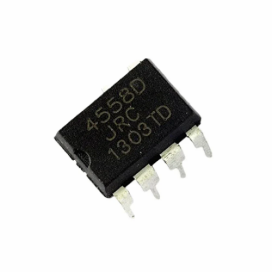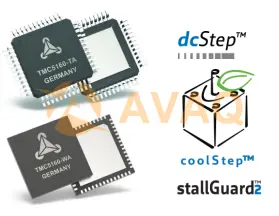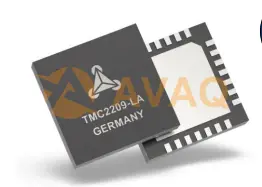-
JRC4558 vs TL072: What are Differences
11/28/2023 at 09:37 • 0 commentsWhat is JRC4558
The JRC4558 is a dual operational amplifier integrated circuit (IC) manufactured by Japan Radio Corporation (JRC), now part of New Japan Radio (NJR). It's a versatile component used in various electronic applications, particularly popular in guitar pedals and audio circuits.
![]()
Known for its robust performance, it offers strong input impedance, substantial voltage amplification (with a gain of up to 100dB), and operates within a wide power supply range (from ±4V to 18V). This IC contains two separate op-amps within its 8-pin package and is available in different formats such as DIP (Dual Inline Package) and SOP (Small Outline Package). Its flexibility and reliability have made it a favorite among engineers, hobbyists, and musicians for decades.
What is TL072
The TL072 is a popular dual low-noise JFET-input operational amplifier (op-amp) manufactured by Texas Instruments. It's part of the TL07x series known for its high input impedance, low noise, and wide bandwidth.
![]()
Main Differences between JRC4558 and TL072
- Technology:
- JRC4558: Utilizes bipolar technology.
- TL072: Uses JFET (junction field-effect transistor) technology.
- Input Impedance:
- JRC4558: Around 5MΩ.
- TL072: Higher due to JFET input technology, offering increased input impedance.
- Noise Performance:
- JRC4558: Moderate noise performance.
- TL072: Known for low noise, particularly suitable for audio applications requiring minimal interference.
- Voltage Noise:
- JRC4558: Moderate, around 18nV/√Hz.
- TL072: Low, also around 18nV/√Hz.
- Bandwidth:
- JRC4558: Moderate bandwidth, around 3MHz.
- TL072: Wide bandwidth, around 4MHz.
- Slew Rate:
- JRC4558: Slew rate around 1V/µs.
- TL072: Higher slew rate, approximately 13V/µs.
- Input Bias Current:
- JRC4558: Around 200nA.
- TL072: Very low, typically under 10pA due to JFET input.
- Input Offset Voltage:
- JRC4558: Around 1mV.
- TL072: Very low, typically under 3mV.
- Common-Mode Rejection Ratio (CMRR):
- JRC4558: Moderate.
- TL072: Typically higher.
- Power Consumption:
- JRC4558: Generally lower power consumption.
- TL072: Can vary in terms of power consumption.
- Voltage Range:
- JRC4558: ±4V to ±18V.
- TL072: ±3V to ±18V.
- Applications:
- JRC4558: Commonly used in guitar pedals, audio circuits, musical equipment.
- TL072: Often employed in audio equipment, precision circuits, and applications where low noise and high input impedance are crucial.
- Technology:
-
TMC5160 vs TMC2209: What are Differences
10/27/2023 at 10:21 • 0 commentsWhat is TMC5160
The TMC5160/TMC5160A is a high-power stepper motor controller and driver IC with serial communication interfaces. It offers a flexible ramp generator for precise target positioning and features the industry's most advanced stepper motor driver. By using external transistors, it enables the creation of highly dynamic, high-torque motor systems.
![TMC5160]()
What is TMC2209
The TMC2209 is an ultra-quiet motor driver IC designed for two-phase stepper motors. Its pinout is compatible with several legacy drivers and the TMC2208. Featuring TRINAMIC's advanced StealthChop2 technology, it ensures noiseless motor operation, maximum efficiency, and optimal torque. With fast current regulation and the option to use SpreadCycle, it allows for highly dynamic motion and includes features like StallGuard for sensorless homing.
![TMC2209]()
Main Differences between TMC5160 vs TMC2209
From Features and Application, let's see the differences between TMC5160 vs TMC2209
Features
Feature
TMC5160
TMC2209
Suitable for
2-phase stepper motors (1 to several 10A)
2-phase stepper motors (up to 2.8A peak)
Voltage Range
8V to 60V DC
4.75V to 29V DC
Communication Interfaces
SPI & Single Wire UART
Single Wire UART & OTP
Microstepping Support
Up to 256 microsteps per full step
Up to 256 microsteps by MicroPlyer™
Special Control Features
SixPoint™ ramp, Resonance Dampening, DcStep™
StallGuard4™, CoolStep™
Noise Operation
StealthChop2™
StealthChop2™
Current Control
CoolStep™ for energy savings
CoolStep™ for energy savings
Protection & Diagnostics
Full Protection & Diagnostics
Full Protection & Diagnostics
Package Size
Compact 7x7mm² TQFP48 package
Compact QFN package with large heat slug
Applications
TMC5160 Application
- High-Power Stepper Motors: The TMC5160 is suitable for applications that require driving high-power stepper motors with coil currents ranging from 1 to several 10A. This makes it a good choice for applications where higher torque and power are needed, such as industrial automation and CNC machines.
- Precise Positioning: It offers features like SixPoint™ ramp, high microstepping resolution (up to 256 microsteps per full step), and encoder interface, making it suitable for applications where precise and smooth positioning is critical.
- Quiet Operation: With features like StealthChop2™ and resonance damping, the TMC5160 provides noiseless operation, making it ideal for applications where low noise is essential, such as 3D printers and medical devices.
- Advanced Control: Its advanced control algorithms and communication interfaces (SPI and Single Wire UART) make it a good fit for applications that require fine-tuned control and diagnostics.
TMC2209 Application
- Low to Medium Power Stepper Motors: The TMC2209 is designed for driving 2-phase stepper motors with coil currents of up to 2.8A (peak) or 2A RMS. It is suitable for applications with lower power requirements, such as 3D printers, smaller CNC machines, and robotics.
- Cost-Effective Solutions: TMC2209 offers a balance between performance and cost, making it a preferred choice for applications where cost-effectiveness is a priority.
- Silent Operation: Like the TMC5160, it incorporates StealthChop2™ technology, providing silent motor operation. This is beneficial in applications where noise reduction is desired, especially in consumer electronics and small-scale automation.
- Ease of Use: TMC2209's straightforward STEP/DIR interface and support for MicroPlyer™ interpolation simplify the integration process, making it a good choice for hobbyist and entry-level applications.
- Energy Efficiency: It features CoolStep™ current control, which can save up to 75% energy. This is advantageous in applications where energy efficiency is a concern.
-
Learn about LT9611UXC Lontium
09/27/2023 at 09:27 • 0 commentsLT9611UXC Lontium Description
The LT9611UXC is a multimedia converter chip manufactured by Lontium Semiconductor Corporation. It is designed to convert MIPI DSI (Display Serial Interface) and CSI (Camera Serial Interface) signals to HDMI 2.0 output. This makes it a valuable component for connecting MIPI-based displays or cameras to HDMI displays or monitors, especially in applications requiring high-resolution video and data transfer.
![]()
LT9611UXC Specifications
Single/Dual-Port MIPI DSI/CSI Receiver:
- Compliant with D-PHY 1.2, DSI 1.3, and CSI-2 1.3 standards.
- Integrated DSC 1.2 decoder.
- Configurable as 1 or 2 ports.
- Supports 1 clock lane and 1, 2, 3, or 4 configurable data lanes per port.
- Data lane speeds ranging from 80 Mbps to 2 Gbps per lane.
- Skew calibration for optimal signal integrity.
- Programmable receiver equalizer.
- Supports data lane swap (arbitrarily) and polarity inversion (independent).
- 3D support: can receive L and R frames or alternate odd-L/even-R pixels.
- Supports DSI in both burst and non-burst modes.
- DSI supports various video formats with or without DSC/CSC.
Digital Audio Input:
- I2S interface supporting 2-channel audio with various sample rates (32-192 kHz) and sample sizes (16-24 bits).
- SPDIF interface supporting PCM, Dolby Digital, and DTS digital audio at up to 192 kHz frame rate.
- IEC60958 or IEC61937 compatible.
HDMI 2.0 Transmitter:
- Compliant with HDMI 2.0b, HDMI 1.4, and DVI 1.0 standards.
- Compliant with HDCP 2.2 and HDCP 1.4.
- Supports a high data rate of up to 6 Gbps.
- On-die back termination.
- Programmable transmitter swing and pre-emphasis.
- AC-couple capable.
- Supports channel swap (arbitrarily) and polarity inversion (independent).
- Capable of supporting 4K resolution at 60Hz.
- Supports 3D formats (side-by-side/full).
- Supports various video formats with or without DSC/CSC.
- HDR (High Dynamic Range) support.
- TMDS scrambling for EMI/RFI reduction.
- Supports SCDC (Status and Control Data Channel).
- 5V tolerance for DDC (Display Data Channel) and HPD (Hot Plug Detect) I/Os.
Miscellaneous:
- CSC (Color Space Conversion): Supports RGB <-> YUV444 <-> YUV422 conversion.
- Integrated CEC (Consumer Electronics Control) controller.
- External oscillator.
- Integrated microprocessor.
- Embedded SPI flash for firmware and HDCP keys.
- GPIOs for system controls.
- Integrated 100/400 kHz I2C slave interface.
- Firmware update capability through SPI or I2C interface.
- Power supply: 3.3V for I/O and 1.2V for the core.
- ESD (Electrostatic Discharge) protection: 4kV HBM (Human Body Model).
- Wide temperature range: -40°C to +85°C.
- Package: QFN64 (7.5mm x 7.5mm).
- Read more: LT9611UXC Lontium: Datasheet, Features and Applications
- Send inquiry: https://www.avaq.com/bom
My Projects
My Pages
Projects I Like & Follow
The Arduino battery tester is a tool by which you can check how much charge a battery is.
Share this profile
ShareBits
Become a Hackaday.io Member
Create an account to leave a comment. Already have an account? Log In.





 Taiwo
Taiwo Liam Lacey
Liam Lacey Mukesh Sankhla
Mukesh Sankhla lion mclionhead
lion mclionhead Dean Segovis
Dean Segovis Samuk
Samuk Maakbaas
Maakbaas little french kev
little french kev Makerfabs
Makerfabs Sixth_Nassau
Sixth_Nassau hIOTron
hIOTron Patrick
Patrick John Rampelt
John Rampelt Lithium ION
Lithium ION ELSHNKHLL
ELSHNKHLL